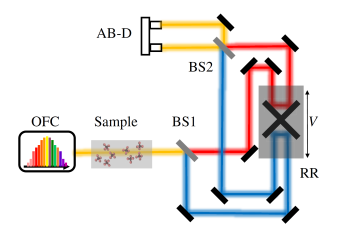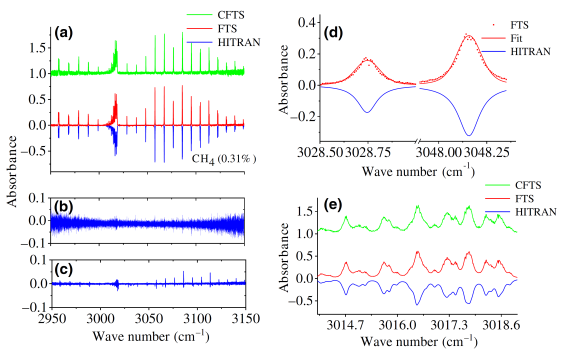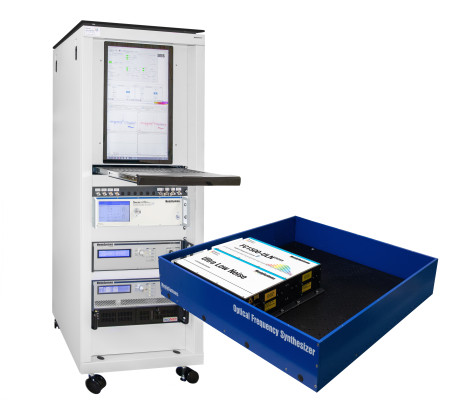Menlo Systems' product:
A compressed view on complex gas mixtures
Using Menlo Systems’ optical frequency comb technology, researchers from the Tsinghua University in Beijing, China, demonstrated a spectroscopic method to recover high-resolution mid-IR spectra from low-rate data sampling with high accuracy.
Laser absorption spectroscopy (LAS) is a widely used method for in situ, nonintrusive measurements of gas concentration, temperature, pressure, and velocity. The most commonly used laser source for the quantitative capture of the complex spectral signatures with high resolution is narrow-band tunable diode lasers. However, their narrow gain bandwidth limits the observation window of molecular transitions, which makes it difficult to procure accurate and comprehensive knowledge of the measurement target with one single set of diagnostic system. Tasks such as combustion diagnostics and chemical reaction kinetics typically involves mixture compositions with both small gaseous species and larger molecules - at potentially high temperature and pressure conditions. Therefore, a spectroscopic method allowing broadband analysis with high spectral resolution is highly favored.

Figure 1: Schematics of the experimental setup. After interacting with the sample, the light of the comb enters the FTS system. OFC: optical frequency comb; BS: beam splitter; AB-D: auto-balanced photodetector; RR: retroreflector; V: translational stage moving velocity
The optical frequency comb (OFC) technology addresses these demands and hence represents a breakthrough advancement for high-precision metrology. Particularly the method of Fourier-transform spectroscopy (FTS) takes advantage of the high brightness, high coherence, and high frequency stability of the OFCs. It computes an optical spectrum from a signal acquired in the time domain by overlapping the two replica of a laser beam with one (or both) varying optical path length on a detector (Fig. 1). OFC FTS therefore offers a viable method for the quantitative analysis of dynamic changes in multispecies sample mixtures.
In view of the simultaneous demand of a small increment of the varying optical path to achieve broad spectral coverage and a large overall optical path difference for high spectral resolution, underlying challenge arises from the large data volume generated in OFC FTS. The high effort for data transfer, processing, and storage greatly hinders the possibility for fast, real-time sensing.
As a solution to this problem, researchers around Professor Xing Chao’s from The Department of Energy and Power Engineering of Tsinghua University applied the concept of compressed sensing (CS) to FTS. This processing technique for signals which are sparce in a certain domain allows efficient signal acquisition and reconstruction from far fewer samples than required by the Nyquist-Shannon theorem - a sampling rate of more than twice the largest frequency present in the measured signal. The spare nature of the OFC with narrow comb teeth, and of the molecular spectra with narrow transition lines spreading over a broad range in the frequency domain makes CS conceptually a good fit for processing the high-resolution broadband spectra from OFC FTS.

Figure 2: Absorption-spectrum measurement results of CH4. (a) Comparison of the recovered CFTS spectrum (green curve), conventional FTS spectrum (red curve), and theoretical calculation according to HITRAN (blue curve); (b) residual between the CFTS and theoretical calculation; (c) residual between conventional FTS spectra and theoretical calculation; (d) excerpt of measured high resolution absorption spectrum and Voigt fitting; (e) excerpt of densely packed Q-branch spectra obtained by CFTS, conventional FTS, and theoretical calculation.
Using Menlo Systems’ optical frequency comb FC1500-ULN, Professor Chao’s group reports methodological and experimental demonstration of a compressed sensing mid-infrared FTS. By applying the compressed Fourier-transform spectroscopy (CFTS) method, they achieved efficient data sampling and accurate spectral recovery with comb-teeth-resolving resolution of 0.0083 cm−1 (250 MHz) over a spectral range of 300 cm−1 (33.333 µm). They validate their CFTS approach against conventional FTS results and theoretical calculations (Fig. 2).
In their work, studies on the effect of compression ratio show that a compressed interferogram using as few as 2% of the regular sample points can effectively recover the high-resolution broadband spectrum with a residual of 1.9% between the CFTS data and theoretical calculations. Future works are under way to further characterize the developed system over a wider range of measurement conditions, and to implement it for real-time embedded systems, jointly with other advanced sensing techniques such as cavity-enhanced spectroscopy and various spectral processing schemes.
Author: Zhaoyang Tai
Original publication:
N. Zhu, Z. Xu, Zh. Wang, Z. Song, W. Wang, X. Chen, and X. Chao:
Midinfrared Compressed Fourier-Transform Spectroscopy with an Optical Frequency Comb;
Physical Review Applied Vol. 18, 024025 (2022)
DOI: 10.1103/PhysRevApplied.18.024025
